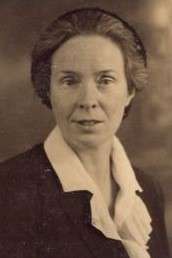Mary Kitson Clark
| Mary Kitson Clark FSA | |
|---|---|
 Kitson Clark in 1940 | |
| Born |
Anna Mary Hawthorn Kitson Clark 14 May 1905 Leeds, Yorkshire, England |
| Died |
1 February 2005 (aged 99) Môr Awel, Llangwnnadl, Gwynedd, Wales |
| Nationality | British |
| Occupation | |
| Spouse(s) | Derwas Chitty (m. 1943–71) |
| Children | 1 |
| Academic background | |
| Education | Leeds Girls' High School |
| Alma mater | Girton College, Cambridge |
| Academic work | |
| Discipline | Archaeology |
| Sub discipline | |
| Institutions |
|
| Notable works | A Gazetteer of Roman Remains in East Yorkshire (1935) |
Anna Mary Hawthorn Kitson Clark, FSA (14 May 1905 – 1 February 2005), married name Mary Chitty, was a British archaeologist, curator, and independent scholar. She specialised in the archaeology of Romano-British Northern England but was also involved in excavations outside the United Kingdom and the Roman period. Her 1935 work, A Gazetteer of Roman Remains in East Yorkshire, "remains one of the starting points for any study of the Romans in the north of England".[1]
Early life and education
Kitson Clark was born on 14 May 1905 in Leeds, Yorkshire, England.[1][2] She was the youngest of three children born to Edwin Kitson Clark (1866–1943) and Georgina Kitson Clark (née Bidder); an elder brother was the historian George Kitson Clark.[2] Her paternal grandfather was Edwin Charles Clark, Regius Professor of Civil Law at Cambridge University, and her maternal great-grandfather was George Parker Bidder, an eminent engineer.[2]
Kitson Clark was first educated at home and then at Leeds Girls' High School, a selective independent school in Leeds.[1][2] She then matriculated into Girton College, Cambridge to study the history tripos.[1] After graduating with a Bachelor of Arts (BA) degree, she remained at the University of Cambridge to study for the one-year diploma in archaeology.[2]
Career
Kitson Clark belonged to the generation of amateur archaeologists who remained as independent scholars; over her lifetime she "witnessed the decline in influence of the amateur, independent scholar, and the rise of a professional class of archaeologist and historian".[1] From 1929 to 1943, she was secretary of the Roman Antiquities Committee for Yorkshire; her father had been its treasurer.[2] During this time, she published her magnum opus, A Gazetteer of Roman Remains in East Yorkshire (1935). It was described in 1990 as a "well-loved, well-thumbed classic",[3] and according to her obituary in The Independent "remains one of the starting points for any study of the Romans in the north of England".[1] From 1941 to 1943, she was also the curator of Roman Antiquities at the Yorkshire Museum in York.[2]
After her marriage in 1943, Kitson Clark remained a member of the Yorkshire Philosophical Society (which, among other things, runs the Yorkshire Museum), becoming its longest-lived Vice-President.[1][2] After the death of her husband in 1971, she continued her research. She published a two-volume monograph on The Monks of Ynys Enlli (1992, 2000);[1][2] the last volume was published just after her 95th birthday.[1]
Kitson Clark was involved in a number of archaeological excavations. She excavated at a number sites in East Yorkshire, and published her findings in Gazetteer of Roman Remains in East Yorkshire (1935).[1] In 1929, she went to Palestine and worked on the Dorothy Garrod led excavations of palaeolithic sites.[2] In 1935, she was part of a team that excavated Petuaria, a Roman fort in Brough, East Riding of Yorkshire.[4]
Personal life
During her involvement in the 1929 excavations in Palestine, Kitson Clark met her future husband Derwas James Chitty (1901–1971); he was also an archaeologist and an Anglican priest.[1][2] On 5 July 1943, she married Chitty.[2] Together they had one child, a daughter.[2] They then lived in Upton, Berkshire, where he served as its vicar.[2] After he retired from full-time ministry in 1968, they lived in Llangwnnadl, Caernarfonshire, Wales.[1] Her husband died in 1971 after a "domestic accident".[1] In her obituary in The Independent it stated that after his death "Mary was much comforted by her strong Christian beliefs".[1]
On 1 February 2005, Kitson Clark died at Môr Awel, Llangwnnadl, at the age of 99.[2] Her funeral and a Requiem Mass were held at St Gwynhoedl's Church in Llangwnadl on 5 February 2005.[5]
Honours
On 13 January 1938, Kitson Clark was elected a Fellow of the Society of Antiquaries of London (FSA); she was the "last surviving fellow elected before the Second World War".[6] In 1985, a conference was held in her honour by British Romanists; the proceedings of this conference were later published as Recent Research in Roman Yorkshire: studies in honour of Mary Kitson Clark (Mrs Derwas Chitty) (1988).[1][2]
Selected works
- Kitson Clark, Mary (1935). A Gazetteer of Roman Remains in East Yorkshire. Leeds: Roman Antiquities Committee of the Yorkshire Archaelological Society.
- Chitty, Mary (1992). The Monks On Ynys Enlli: Part One c.500 AD to 1252 AD.
- Chitty, Mary (2000). The Monks On Ynys Enlli: Part Two 1252 AD to 1537 AD.
References
- 1 2 3 4 5 6 7 8 9 10 11 12 13 14 15 Briggs, C. Stephen (18 March 2005). "Mary Kitson Clark: Archaeologist of Roman Yorkshire". The Independent. Retrieved 11 October 2016.
- 1 2 3 4 5 6 7 8 9 10 11 12 13 14 15 16 Gash, Norman (January 2013). "(Anna) Mary Hawthorn Kitson Clark (1905–2005)". Oxford Dictionary of National Biography. Oxford University Press. doi:10.1093/ref:odnb/97577.
- ↑ Wild, John Peter (1990). "Reviewed Work: Recent Research in Roman Yorkshire. Studies in Honour of Mary Kitson Clark (Mrs Derwas Chitty)". Britannia. 21: 425. doi:10.2307/526330. JSTOR 526330.
- ↑ "Occupied by the Romans". The Evening Telegraph and Post (18329). 24 August 1935. p. 4.
- ↑ "Deaths: Chitty". The Independent (5710). 4 February 2005. p. 34.
- ↑ "Obituaries". Salon. Society of Antiquaries of London. 112. Retrieved 11 October 2016.